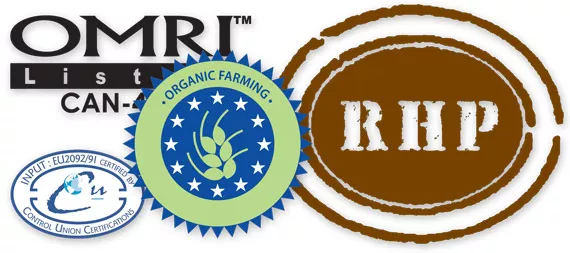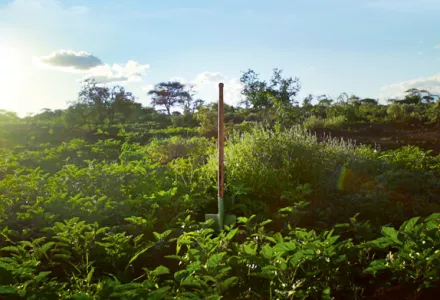Organic, inorganic, mineral, natural, all natural... What does this all mean and why are some of these terms bantered about so loosely? It is confusing and made more so by the complexities of our political systems and advertising agencies. That aside for now, lets look at the correct meaning of these terms and the implications it has for the grower and their choice of crop and system.
Let us start with some basic definitions:
1. Mineral
The inorganic salts, including sodium, potassium, calcium, chloride, phosphate, sulphate, etc. So called because they are (or originally were) obtained by mining. They are not necessarily natural.
2. Organic
Chemically, a substance containing carbon in the molecule (with the exception of carbonates and cyanide). Substances of animal and vegetable origin are organic. It can also mean many other things from body parts to growing styles including defining the most fundamental laws of a government. Loosely translated it means good (unless a body part is involved in which case it is a type disease, or the law if you violate it). They are also not necessarily natural.
3. Inorganic
Simple enough, it is not Organic. See mineral. They are also not necessarily natural.
4. Natural
Present in or produced by nature. Then the definition goes on for ten additional pages including talent and a color described as a yellowish gray to pale orange yellow (how can that be natural?). For us, it basically means that it was not made by man but was harvested or processed from nature. These should be necessarily natural but it really depends on whose definition we use.
5. Synthetic
Man made or, more precisely not natural: artificial or contrived.
Now that we are well versed in the definitions, let us look at each one as it relates to selecting parts and components for growing systems.
Plant roots can be selective in what elements they let through the cell membranes and into the plant itself. It is a system comprised of many components that work by allowing access for all elements smaller then a particular size by diffusion; actively moving very specific molecules such as nitrate or larger single elements; or other varied methods. Mineral elements are the ones that will break down and be available faster then anything else.
Since all elements, including those applied organically, must exist as a single element to cross into a cell (excluding specialty molecules), and organically applied components are still complex molecules waiting further breakdown into usable end products, Synthetic Inorganic minerals will react quicker with a plant and can be controlled more precisely. They are supplied in many combinations like Ammonium Nitrate, Calcium Nitrate, Potassium Sulphate, or Potassium Phosphate, ions that disassociate in solution and the plant can take them up.
Unfortunately, when they are supplied with undesirable components such as Sodium Molybdate, or when the ‘mined’ material is not pure, these impurities or undesirable components cause problems. This is especially true where heavy metals are concerned. These undesirable elements can either be deposited into the medium causing salt and other toxicity problems, or pass into the plant to be deposited into the cell vacuoles where they remain until consumed by the end user or degrade into the soil.
Basic concepts of 'organic'
Organic, as the term is used in the Green Industry, implies two basic concepts. One is material based as in the source of Nitrogen is an organic molecule, and contains Carbon as noted earlier, that has to be broken down to be available. It also refers to the end product, plant or fruit, harvested or used, for example; the lettuce is Organic which means everything done to the crop was done with all Natural and Organic programs for feeding, pest control, etc. Let us understand that a combination product like a fertilizer can have organic components with mineral elements combined and be either Organic or not, depending on both components.

Organic components are recognized as either synthetic or natural; they are either man made or not. When the subject is fertilizer, for instance, typically it is the Nitrogen that is worked with and everything else is incidental. Natural Organic Nitrogen is sup- plied by whole components of once living things from plant to animal; components such as manure, leaf mold, or blood meal. These require organisms to finish the breakdown so they, too, must be present and the Nitrogen becomes available slowly.
Synthetic Organic Nitrogen includes compounds such as Urea, or Urea formaldehyde (UF) that release based on microbes, temperature, pH or other conditions of the medium. This Nitrogen is available fairly rapidly although some breakdown must occur. There are advantages to any of these and disadvantages, the faster they are available, the less time they spend available to the plant and the greater the chance of burn. Also, to fit into the Organic Program, they have to be Natural Organic. The remaining component supplied elements are almost incidental in their presence in the fertilizer mix. Only by carefully selecting the most suitable feed stock for decomposition, selecting or designing the right microbes to break down the feed stock, and by engineering the pathway of decomposition can an organic fertilizer, such as BIOCANNA Bio Vega and Bio Flores for example contain a specific and known nutrient value.
If the other main components of a fertilizer are needed to make it complete, then it has to be added to the Nitrogen mix, or added separately. Using a blend of plant and animal derived components will get close to all the required elements, but not for all. A grower that feeds 100 % organic components will never maximize their crop. Certain components like Calcium are needed in large amounts but consumed in the degradation process. Bone meal can be added for the additional Phosphorous needed, but not for all organic consumers, some want no animal by-products to be used as well. The next best option is to supplement what is needed to get the ratios correct, with naturally available elements such as Calcium Carbonate (Lime) or Rock Phosphate.
However, the material can no longer be described as ‘Organic’ but is now ‘Natural and Organic’. As noted earlier, this same description, Natural and Organic, could apply to a Synthetic Organic Nitrogen and heavy metal contaminated Rock Phosphate. Confused yet?
Summary
So, as a review, we see that the term organic means many things and the same thing, so does natural, and yet both can be used at the same time to achieve better results. What to do? A grower needs to understand a few important points first:
Certain components exist in almost all natural mineral soils fit to grow in, why grow in pure organic? Important components like Calcium are supplied in lime, phosphorous exists in all soils too, either as bound or as free, phosphate is the oxidized form and occurs in all mineral soils (most is bound up in Calcium – Phosphate interactions and remains unavailable). Using Natural Organic components requires the proper root environment containing the microbes necessary to break down the organic components, and the physical conditions of temperature, moisture and pH will affect the process and must be taken into account.
A grower that feeds 100 % organic components will never maximize their crop
Growing ‘Organic’ requires not just the proper fertilizer, but every component must meet the standards. Seed or cuttings used must be from ‘Organic’ stock, pest control has to be 100% Natural or naturally derived compounds from plants or animals. (This begs the question if growing under lights is Natural).
Materials used to produce components of Organic systems must be Organic as well. If plant extracts are used, for instance, then the plants must have been produced ‘Naturally’ and ‘Organically’ as well.
Growing Organically requires time, as the materials used for feed take some time to become broken down enough to supply a plants needs. It can be a long process with tens of processes required to take an organic component like a cell wall and turn it into an available single element or specialty molecule like nitrate.
With fertility, Natural Organic growing requires that a microcosm be established to deal with the organic component needing reduction. You can add all the manure, castings, and blood meal you want to the medium, but without the micro-life, it will sit there. It may breakdown some under reduction-oxidation pathways, but not enough to feed a crop. It takes organisms that feed the raw proteins or other components, then another organism to feed those waste products, and another until the compound is rendered to a plant usable form. It takes balance between organisms to get the nutrients correct: micro-flora, -fauna has to be present at the right time.

All this has to occur in the root zone in a medium that will support this; an organic base with storage sites, so our system is limited to soil or soilless organic based mediums, usually peat since the values will work with the organics. The best feed to use would be one that is as close to the final stage of break- down as possible; this takes the variability and guess work out of it. Organic ‘Teas’ or liquid compost is an example of being closer to the end results, how- ever, all are different and will tend to vary with the components being turned into tea and the season- al changes in temperature (or any other external factor) of the ‘brewing’ facility. In a perfect world, giant fermentation tanks would take raw materials and render them to a liquid fertilizer by the careful addition of specific soil borne microbes that would work on the first step only, and once they digested everything they could, they would be removed and replaced by the next step’s microbes.
This would be repeated by the same microbes engineered to produce very particular compounds, all the way to the final step, where it would be bottled and sold. Once applied this would be reduced immediately at the root surface to become available, with little delay, to the plant. All the while, the materials and process would be 100% Natural and Organic and would include nothing added but the microbes (if they are even needed by this step): wishful thinking, perhaps, but one doable with future technologies. CANNA produces Bio soil/ soilless medium fertilizer that is produced in exactly this fashion. They are called Bio Vega and Bio Flores for respectively the growth and flowering stages.
'Organic' organisations
Unfortunately, all the technologies in the world will do little to clarify the industries use of words like natural and organic. Fortunately, there have been laws that have been promulgated to limit what can be said on labels and advertising, and organizations were started to sanction components and processes as fitting into an Organic System or Organic program. This is done to insure the consumer gets what they think they are getting.
Organizations like OMRI (Organic Materials Review Institute) and the European Control Union look at the materials being labeled Organic or Organic Produced and certify the materials and processes used. Not only do they review the types and origins of materials used, but govern the process from harvest to bottling. They also recognize the inability of pure organics to pro- vide for all the required elements for a plant and allow certain components to be used that are natural and clean. These are paid services that guarantee the product and process. The government, on the other hand, should be providing controls on the use of these words on the product labels.

Some governments regulate the design and con- tent of labels for fertilizer and pesticide labels. Most will not let the word ‘Organic’ or ‘Natural’ be used on the label without meeting certain criteria. Some follow the review institutes’ guidelines; some are much stricter allowing organic to be used when the only components of a product are plant or animal based. Registration is designed to protect the purchaser and consumers from illegitimate companies selling bad things with confusing or false claims and statements. The grower has to do the rest of the legwork to decide which route is best for them.
So, there is the problem in a nut shell. It is confusing; just remember, do the homework. Find out the metal contents, find out where the technology is coming from, use registered products, find out how it is produced, and use it correctly. How ‘Organic’ does this need to be? What crop am I growing (some species do not do as well on organic systems preferring waste type soils)? How will this be done? What can be reasonably anticipated from this method? If you want Organic then use OMRI or Control Union listed products, makes it really easy. These are all questions the grower must decide be- fore deciding on how organic to grow, and what materials to use. Take some advice, keep it simple, and understand the way it works and the limitations it has, but enjoy the benefits of growing ‘Organic’. Work within the limits, and keep an eye out for that perfect product.
References
www.omri.org - Organic Materials Review Institute
www.controlunion.com - Control Union World Group



